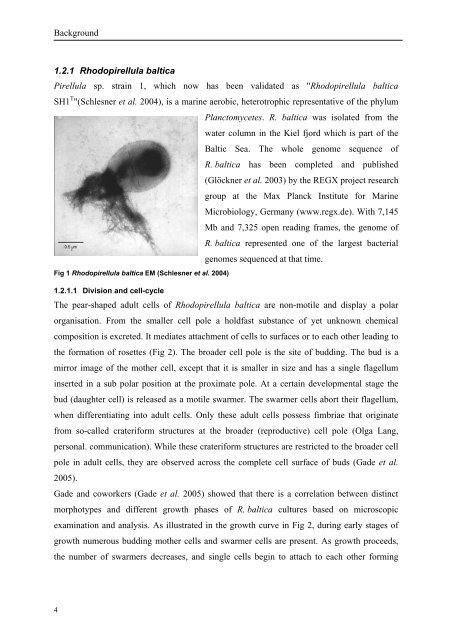a Whole Genome Array Approach - Jacobs University
a Whole Genome Array Approach - Jacobs University
a Whole Genome Array Approach - Jacobs University
Create successful ePaper yourself
Turn your PDF publications into a flip-book with our unique Google optimized e-Paper software.
Background<br />
1.2.1 Rhodopirellula baltica<br />
Pirellula sp. strain 1, which now has been validated as "Rhodopirellula baltica<br />
SH1 T "(Schlesner et al. 2004), is a marine aerobic, heterotrophic representative of the phylum<br />
Planctomycetes. R. baltica was isolated from the<br />
water column in the Kiel fjord which is part of the<br />
Baltic Sea. The whole genome sequence of<br />
R. baltica has been completed and published<br />
(Glöckner et al. 2003) by the REGX project research<br />
group at the Max Planck Institute for Marine<br />
Microbiology, Germany (www.regx.de). With 7,145<br />
Mb and 7,325 open reading frames, the genome of<br />
R. baltica represented one of the largest bacterial<br />
genomes sequenced at that time.<br />
Fig 1 Rhodopirellula baltica EM (Schlesner et al. 2004)<br />
1.2.1.1 Division and cell-cycle<br />
The pear-shaped adult cells of Rhodopirellula baltica are non-motile and display a polar<br />
organisation. From the smaller cell pole a holdfast substance of yet unknown chemical<br />
composition is excreted. It mediates attachment of cells to surfaces or to each other leading to<br />
the formation of rosettes (Fig 2). The broader cell pole is the site of budding. The bud is a<br />
mirror image of the mother cell, except that it is smaller in size and has a single flagellum<br />
inserted in a sub polar position at the proximate pole. At a certain developmental stage the<br />
bud (daughter cell) is released as a motile swarmer. The swarmer cells abort their flagellum,<br />
when differentiating into adult cells. Only these adult cells possess fimbriae that originate<br />
from so-called crateriform structures at the broader (reproductive) cell pole (Olga Lang,<br />
personal. communication). While these crateriform structures are restricted to the broader cell<br />
pole in adult cells, they are observed across the complete cell surface of buds (Gade et al.<br />
2005).<br />
Gade and coworkers (Gade et al. 2005) showed that there is a correlation between distinct<br />
morphotypes and different growth phases of R. baltica cultures based on microscopic<br />
examination and analysis. As illustrated in the growth curve in Fig 2, during early stages of<br />
growth numerous budding mother cells and swarmer cells are present. As growth proceeds,<br />
the number of swarmers decreases, and single cells begin to attach to each other forming<br />
4

















